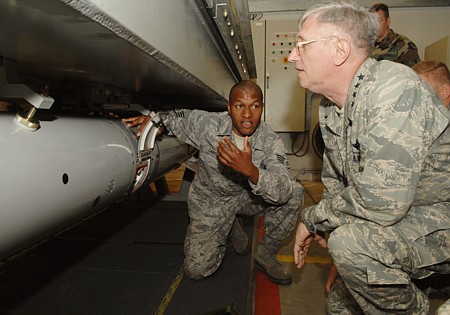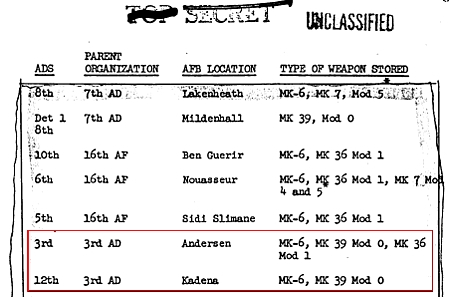Presidential Candidates Need to See Beyond Warhead Numbers

By Hans M. Kristensen and Ivan Oelrich
Barack Obama has put forward an inspiring nuclear security policy that promises to reinstate nuclear disarmament as a central goal of U.S. national security and foreign policy. This vision has been shared by all presidents since the Cuban Missile Crisis, except for George W. Bush.
If he is elected the next president, Obama’s policy would be a refreshing break with the gung-ho and divisive policies that have characterized the current administration.
Even so, it is important to consider the intent of Obama’s policy and look ahead to how it could be implemented and even improved.
The Role of Nuclear Weapons
The part of the policy that deals with existing nuclear weapons (versus proliferation) is very much focused on numbers. When both the United States and Russia clearly have far, far more nuclear weapons than either could conceivably need, it is tempting to ignore details and just make big cuts in numbers. But to move the process convincingly toward diminishing the salience – and eventually toward abolition – of nuclear weapons it is necessary to develop a vision for what role the nuclear weapons should play in U.S. national security policy. Short of some very general statements, Presidents traditionally leave this matter to the Secretary of Defense and the National Security Council. This practice has gotten us into a lot of trouble in the past as policy and military planners transformed vague presidential guidance into excessive and dangerous nuclear postures.
Other than a pledge to negotiate with Russia about ending high alert of nuclear weapons, there is nothing in Obama’s policy that suggests the role of nuclear weapons would be any different under him than under Bush or Clinton. Clearly, this is a shortcoming of his proposal. Statements from Senator McCain are even more worrying: he has said he will ask the military for a review and to report back on the minimum number needed, implying quite clearly that the military, not the president, will make important decisions about what role nuclear weapons ought to have.
The (first) Bush and Clinton administrations significantly changed the role of U.S. nuclear weapons from deterring and destroying Soviet and Chinese nuclear and large-scale conventional forces to deterring use and acquisition of all forms of weapons of mass destruction in all adversarial countries with such capabilities. Moreover, in response to 9/11, the Bush administration rushed forward a highly aggressive preemption doctrine that included nuclear strikes.
To change the role of nuclear weapons requires direct, sustained intervention by the next president. Therefore, both Senators Obama and McCain need to think hard about what his guidance would be on such issues as:
* Should the United States abandon its current policy of deterring all forms of weapons of mass destruction and only use nuclear weapons to deter use of nuclear weapons?
* Should the United States adopt a no-first-use policy or is it still necessary to retain the option to strike first?
* Should the United States retain counterforce targeting, return to countervalue targeting, or develop another concept for what facilities to target with nuclear weapons?
* Should the United States significantly lower and change the damage expectancy required for nuclear strikes?
* Should the United States abandon its policy of being capable of holding all potential targets at risk or is a more limited range sufficient today?
* Should the United States discontinue the practice of having nuclear weapons operationally deployed – including operating daily under a fully executable plan – or could sufficient deterrence be retained by a far less operational posture?
* Should the United States complete the 1991-1992 reductions and withdraw the remaining tactical nuclear weapons from Europe and instead rely on long-range weapons to provide a nuclear umbrella to our NATO allies?
|
No to No-First-Use |
 |
|
Defense Secretary William Cohen of the Clinton administration rejected a no-first-use policy. Will an Obama administration be any different? |
If the next president doesn’t address such fundamental policy issues in his first guidance, the outcome of the next Nuclear Posture Review will almost certainly be little more than status quo at lower levels, leaving in place a posture of excessive nuclear capabilities that the United States doesn’t need but which locks it into a warfighting deterrence posture that works against a vision for deep cuts and disarmament.
The End Goal
The component of Obama’s policy that deals with deep nuclear cuts and disarmament comes with important caveats. One is a pledge to “maintain a strong deterrent as long as nuclear weapons exist,” a position the Bush administration also shares, but which presents a particular conundrum for a policy that seeks nuclear disarmament: if all nuclear weapon states insist on having nuclear weapons as long as nuclear weapons exist, how can we ever get to zero? That would leave U.S. nuclear policy (and nuclear disarmament) hostage to any country that had just one nuclear weapons, even if our conventional capabilities are more than sufficient to deter anyone who can be deterred (Iran and North Korea being obvious examples).
At some point in the process, some of the nuclear weapon states – eventually all – have to be prepared to relinquish the weapons. This is not unheard of; Belarus, Kazakhstan, South Africa and Ukraine have already gone to zero. A “disarmament-president” has to think this conundrum carefully through.
Getting to deep cuts and certainly to global elimination of nuclear weapons might require wholesale revision of the role that military forces play in the world. The national security of the United States – and many other large military powers – is deeply rooted in a military posture aimed at threatening other countries if they do things we don’t like.
|
“As Long As |
 |
|
Would an Iran with a few nuclear weapons prevent the United States and others from going to zero even though they have overwhelming conventional capabilities? |
It is very hard see why other nuclear powers – some of which are our or other nuclear powers’ potential adversaries – would agree to move beyond deep cuts to actual nuclear disarmament as long as the United States pursues military superiority and unconstrained forward offensive operations. Would Russia and China agree to deep nuclear cuts when we’re developing conventional prompt global strike long-range weapons with hard target kill capability that can threaten their remaining forces?
Would Japan agree to the United States eliminating the nuclear umbrella as long as China modernizes and builds up it conventional capabilities? Would Israel agree to disarmament as long as they are surrounded by conventionally armed potential enemies?
Many government and military officials therefore effectively dismiss disarmament by saying: not until there is peace and brotherhood among men. In other words, certainly not in our lifetime or that of our children. Obama’s policy to some extend acknowledges this with a second caveat by talking about the “long road” toward elimination of nuclear weapons.
Ideally, these threats and insecurities must be addressed in a broader context of the relations between states and of the legitimacy of force but, no, all the world’s security problems do not have to be solved before we can consider the elimination of nuclear weapons. Three points are important particularly from a U.S. perspective.
First, there is no need to give some fifth-rate country like North Korea a veto over U.S. nuclear policy. North Korea may very well be developing nuclear weapons to deter the United States but that does not mean the United States, with overwhelming conventional military superiority, needs to have nuclear weapons to deter North Korea, even North Korea’s nuclear use.
Second, the nuclear disarmament of the big nuclear powers will make the nuclear disarmament of troublesome regimes like Iran and North Korea easier, not harder. Some Iranians talk of their nuclear program making them a “world power,” a conceit that would be completely laughable except the established nuclear powers do, in fact, often attach such significance to simply owning nuclear weapons. Delegitimizing nuclear weapons reduces their appeal. North Korea provides a different example: the United States, China, and Russia publicly claim that North Korea’s nuclear weapon program is intolerable, a concern that has only slowly impressed itself on the North Koreans. But imagine that China, the North’s only real patron, had eliminated its own weapons; would the Chinese tolerate their tiny neighbor’s nuclear program then?
Third, and probably most important, while global nuclear disarmament may depend on significant changes in the world’s attitudes toward the use and legitimacy of force, working toward nuclear disarmament can do much to bring about those very changes. Short of willingness to jumpstart the process by taking bold unilateral steps like big reductions in warhead numbers and success in changing the mindsets of all the nuclear powers and their allies, the “long road” might be very long indeed.
Despite these shortfalls, the nuclear policy Obama has put forward would, if it became U.S. policy, be a huge step forward in restoring traditional U.S. nuclear policy priorities and curtailing the role and salience of nuclear weapons in the world. By addressing the issues we have described, it could even be the beginning of the end for nuclear weapons.
Background: Obama’s Plan for a 21st Century Military | Missions for Nuclear Weapons After the Cold War
STRATCOM Cancels Controversial Preemption Strike Plan
 |
|
The controversial preemption strike plan CONPLAN 8022 has been canceled and the mission instead merged with the main U.S. strategic war plan. |
By Hans M. Kristensen
The U.S. military has canceled a controversial war plan designed to strike adversaries promptly – even preemptively – with conventional and nuclear weapons. The strike plan was known as Concept Plan (CONPLAN) 8022 and first entered into effect in the summer of 2004 to provide the president with a prompt, global strike capability against time-urgent and mobile targets.
CONPLAN 8022 was the first attempt to operationalize the “Global Strike” mission assigned to U.S. Strategic Command in January 2003. The mission was triggered by new White House guidance following the terrorist attacks in September 2001 and fear of proliferation of weapons of mass destruction.
Lack of leadership and definition has since placed Global Strike in limbo, with little progress and prompt effects instead being incorporated into other existing strike plans. “Global Strike” is now described as a much broader mission synonymous with the “New Triad” first articulated by the Bush administration’s 2001 Nuclear Posture Review.
CONPLAN 8022’s Short Life
Like its mission, CONPLAN 8022’s life was prompt and brief. STRATCOM completed the first version of the plan in November 2003, based on White House and Pentagon guidance issued in response to 9/11. The requirement was to develop a plan that could be used to strike high-value and mobile weapons of mass destruction (WMD) targets quickly with conventional or nuclear weapons before they could be used against the United States and its allies.
The Global Strike mission was formally assigned to STRATCOM in January 2003 and, in June 2004, Defense Secretary Donald Rumsfeld and CJCS General Richard Myers issued the “Alert Order” that ordered STRATCOM to put CONPLAN 8022 into effect. In July 2004, STRATCOM commander General E. Cartwright reported to Congress that Defense Secretary Donald Rumsfeld had “just signed the Interim Global Strike Alert Order, which provides the President a prompt, global strike capability” (see Global Strike Chronology for more details).
|
Figure 1: |
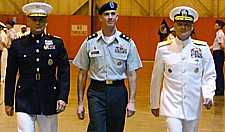 |
|
One of General James Cartwright’s (left) first acts after taking over as commander of STRATCOM in July 2004 was to withdraw CONPLAN 8022, developed by his predecessor Admiral James Ellis (right). |
Shortly after CONPLAN 8022 was brought up to full operational status, however, General Cartwright “withdrew” the plan in the fall of 2004, according to a document provided by STRATCOM in response to a Freedom of Information Act (FOIA) request. It is still murky what the term “withdrawn” implies, because several public documents and personal communication with STRATCOM continued to refer to CONPLAN 8022 after the fall of 2004. Cartwright has since declined to explain why he “withdrew” the plan, but his public statements in 2004-2006 suggest that he was concerned that the only actual prompt weapons in the plan were nuclear, and that this was not a credible posture.
As a concept plan, moreover, CONPLAN 8022 was not intended to be in effect continuously but designed to be brought into effect if necessary. After the plan was brought up to full operational status in 2004, it is possible that CONPLAN 8022 was “withdrawn” or returned to concept status once more. As of March 2006, STRATCOM told me, the plan “was still in its original version, with no revisions.”
But a year later, in July 2007, STRATCOM informed me that CONPLAN “8022 doesn’t exist.” When asked if the plan had been canceled or just deactivated, the officer said “there is no such plan anymore.” It “was underway, but didn’t go anywhere.”
|
Figure 1: |
 |
|
Even slow bomber deployments, like this B-2 deploying to Guam in 2006, are described as “Global Strike.” |
Global Strike Confusion
After cancellation of CONPLAN 8022 there has been significant confusion about what Global Strike actually is. After initially being “sold” as an urgent, unique and separate mission for limited, short-duration, quick-strike options against high-value and mobile targets not covered by other existing plans, Global Strike is now described as many things, ranging from Special Operations Forces raids (boots on the ground) to the traditional nuclear posture of long-range strategic nuclear weapons. Even slow bomber deployments are called Global Strike these days (see Figure 1 and 2; for an example of a recent Global Reach mission described as Global Strike, go here).
Some call it Global Strike, others call it Prompt Global Strike, while others again call it Conventional Prompt Global Strike, depending on who is talking and what weapon program is being promoted. General Cartwright sometimes tried to clarify the structure by saying Prompt Global Strike was a conventional subset of Global Strike, which was a subset of the strategic war plan. But his efforts seem to have had little impact on the debate.
|
Figure 3: |
 |
|
Slow B-52 bomber have conducted several Global Strike exercises, such as this quick-launch practice at Minot AFB in 2007, even though the platform is clearly not a prompt weapon. |
A recent GAO report found that the different Services and agencies have very different understandings of what Global Strike means. The varied interpretation of Global Strike, GAO concluded, “affects their ability to clearly distinguish the scope, range, and potential use of capabilities needed to implement global strike and under what conditions global strike would be used in U.S. military operations.” In response to the GAO findings, STRATCOM agreed to “develop a common, universally accepted concept and definition for ‘Global Strike’.”
Congress has been generally reluctant to fund new exotic weapons for the Global Strike mission. Future Years Defense Program (FYDP) planning has identified, according to GAO, 94 program elements that would provide funding for 135 programs, projects, and activities having possible application for Global Strike. But for now, more than five years after STRATCOM was assigned the Global Strike mission, the Department of Defense concedes that “global strike, as a validated and executable concept, has not matured to the point that it is an extant executable capability….”
Unfortunately, the GAO report only discusses the conventional aspects of Global Strike, even though it was the nuclear option that originally triggered Congressional interest in the mission. After I disclosed in 2005 that preemptive global strike options were being incorporated into a revision of the Doctrine for Joint Nuclear Operations (JP 3-12), more than a dozen members of Congress – including Ellen Tauscher and Jack Reed – objected in a letter to the president to what they considered to be a dangerous change of U.S. nuclear policy. Yet the nuclear option today remains the only executable prompt component of Global Strike.
“Global Strike” or just global strike
Despite the cancellation of CONPLAN 8022 and confusion over the Global Strike mission, however, planning for quick-reaction, short-duration strikes against high-value and fleeting (mobile) targets has continued at STRATCOM, officials confirm.
Instead of a separate CONPLAN, the Global Strike mission is being incorporated into the existing strategic war plan known as OPLAN 8044, offered to regional combatant commanders, and can probably also be found in the new Combat Weapons of Mass Destruction plan known as CONPLAN 8099. The combat employment portion of OPLAN 8044, previously called the SIOP (Single Integrated Operational Plan), was renamed in 2003 to reflect that the “single” top-heavy SIOP has been taken apart and converted into “a family of plans.” Compared with the SIOP, OPLAN 8044 includes “more flexible options” for potential use in a “wider range of contingencies,” according to military documents.
The “family of plans” is the result of a reorganization that has been underway since the early 1990s, when STRATCOM began to create “adaptive planning” missions tailored against rogue states armed with WMD. Back then, the first STRATCOM commander General George Lee Butler described how the SIOP was “evolving to a collection of far more differentiated retaliatory choices, tailored to a threat environment of greater nuance and complexity.”
The Bush administration adopted “tailored” as a central planning objective in its 2001 Nuclear Posture Review that ordering the development of a “New Triad” with more strike capabilities and options. Curiously, the offensive leg of the “New Triad” with its nuclear, conventional and non-kinetic strike capabilities has now become synonymous with Global Strike. Before CONPLAN 8022 was withdrawn, the Pentagon’s Strategic Deterrence Joint Operating Concept, for which STRATCOM was the lead agent, portrayed Global Strike as separate from nuclear strike capabilities (although it wasn’t). In the updated version from December 2006, however, Global Strike is portrayed as synonymous with the offensive leg in the New Triad (see figure 1).
|
Figure 4: |
|
 |
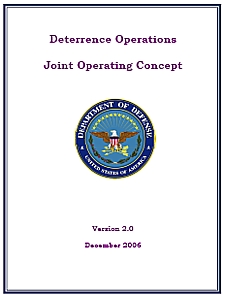 |
| “Direct Means” list (2004): – Force projection – Nuclear strike capabilities – Active and passive defenses – Global Strike – Strategic deterrence information operations – Inducement operations – Space control |
“Direct Means” list (2006): – Force projection – Active and passive defenses – Global Strike (nuclear, conventional, non-kinetic) – Strategic communications |
| Nuclear and non-nuclear offensive weapons have been merged under Global Strike in the 2006 STRATCOM-led Joint Operating Concept. The 2004 version, by contrast, listed the capabilities as separate. In the 2006 revision, however, the Global Strike mission description begins with nuclear and appear synonymous with the offensive leg of the “New Triad.” | |
To implement, maintain and execute the Global Strike mission, STRATCOM established the Joint Functional Component Command for Space and Global Strike (later changed to Joint Functional Component Command for Global Strike and Integration, JFCC GSI). The Concept of Operations document for the new command shows that its responsibilities reach far beyond Global Strike to all strategic strike planning for OPLAN 8044. Through JFCC GSI, STRATCOM is transforming its formerly secluded strategic nuclear strike enterprise into an integrated planning and strike service for national-level and regional combatant commanders. For JFCC SGI, that means integrating STRATCOM’s global strike capabilities into theater operations. A separate CONPLAN 8022 and OPLAN 8044, by contrast, would have constituted separation of planning.
STRATCOM’s current fact sheet on JFCC GSI – all that has survived from several pages previously posted on the command’s web site – shows a component command that has responsibility for the full range of strike capabilities in a planning architecture with Global Strike intertwined with traditional deterrence.
Some Implications
The Global Strike mission was launched with much fervor on the heels of a new preemption strategy following the 2001 terrorist attacks. But it is hard to take seriously the claim that Global Strike – meaning unique prompt strike capabilities other than those already in the inventory – is essential for national security when, more than five years after the mission was established, the Pentagon still hasn’t developed an executable capability or even a succinct definition for what Global Strike means.
In hindsight it seems that rather than developing a unique preemptive plan, planners have instead incorporated the concept into the remnants of the strategic war plan. This “integration” has become the guiding principle for military planning despite its slow start, and has reinvigorated the strategic planning community by creating requirements for an increased number of strike options and contingencies.
Mixed in with this morass of increasingly diffuse global strike capabilities are nuclear weapons, which ought to be clearly and unequivocally identified as a last resort that is separate from the dynamic Global Strike mission. The GAO report notes that “nuclear systems would be part of the portfolio” but doesn’t examine this part of Global Strike. Hopefully Congress’ Strategic Posture Review Commission and the next administration’s Nuclear Posture Review will.
Background information: Global Strike Chronology | Global Strike Concept of Operations | GAO: Strengthen Implementation of Global Strike
The RISOP is Dead – Long Live RISOP-Like Nuclear Planning
 |
| Launch control officers at Minot Air Force Base practice launching their high-alert ICBM. But the hypothetical Russian nuclear strike plan that originally led to the requirement to have nuclear forces on alert has been canceled. So why are the ICBMs still on alert? |
.
By Hans M. Kristensen
The U.S. military has canceled the Red Integrated Strategic Offensive Plan (RISOP), a hypothetical Russian nuclear strike plan against the United States created and used for decades by U.S. nuclear war planners to improve U.S. nuclear strike plans against Russia.
The cancellation appears to substantiate the claim made by Bush administration and military official, that the 2001 Nuclear Posture Review removed Russia as an immediate contingency for U.S. nuclear strike planning. But implementing the shift was not a high priority, lasting almost the entire first term of the administration.
Despite the shift, however, declassified documents obtained under the Freedom of Information Act also show that RISOP-like and “red” analysis continues, and that that the cancellation was necessary to allow STRATCOM to broaden nuclear strike planning beyond Russia.
A Brief RISOP History
The RISOP dates back to the 1960s shortly after the first SIOP (Single Integrated Operational Plan), the Cold War name for the overall U.S. strategic war plan. An important element of refining and improving the effectiveness of the SIOP was to “wargame” it against the Soviet Union and more recently Russia. To do that, planners at Joint Staff and Strategic Air Command (SAC) developed a hypothetical Soviet War plan based on the latest intelligence about Soviet/Russian doctrine, strategy and weapons capabilities. To assist with coordination and planning, Joint Staff established the Red Planning Board (RPB), which included members of all the services and key agencies but was chaired by Joint Staff.
|
Figure 1: |
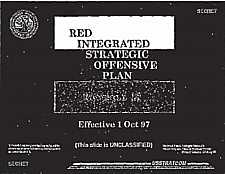 |
|
RISOP updates coincided with SIOP updates. The following declassified (heavily redacted) briefings show the content and structure of the 1996, 1997 and 1998 RISOP plans: * Joint Staff RISOP-96 Brief, April 1995 |
RISOP was based on the latest intelligence about Soviet/Russian nuclear strategy and forces, but the declassified documents show that Joint Staff and STRATCOM did not consider it an intelligence appraisal of those capabilities. Nor did it represent a judgment on the most likely Russian geopolitical intentions. Instead, RISOP was described as one of many possible and plausible courses of action based on Defense Intelligence Agency estimates of Russia force employment consistent with their military doctrine. But since planners probably didn’t want to wargame SIOP against anything but the “real” threat, RISOP most likely was the best possible estimate of the Russian posture.
RISOP was primarily a U.S. nuclear war planning tool. As a detailed opposing force threat plan, it was used by SAC and later STRATCOM in computer simulations to evaluate updates to the SIOP plan; RISOP updates coincided with SIOP updates. RISOP was also used to conduct force structure, arms control, and continuity of government analysis, and to carry out communications studies and prelaunch survivability computations and other strategic analysis.
The Slow Wheels of Change
Responsibility for production of RISOP was transferred from Joint Staff to STRATCOM in late 1996. The RPB was maintained, however, to ensure, among other things, that STRATCOM didn’t “cook the books,” as one of the declassified briefings put it. But the 2001 Nuclear Posture Review (NPR) changed the planning assumptions against Russia. Whereas the RISOP plans of the late 1990s (see Figure 1) envisioned Russian nuclear attacks against the United States, its allies, and China, those assumptions were clearly out of sync with the political and military realities in Russia. The NPR instead determined that “a [nuclear strike] contingency involving Russia, while plausible, is not expected,” and that the size of the operational U.S. nuclear arsenal is “not driven by an immediate contingency involving Russia.” Thus, the overall planning assumption shifted from urgent to plausible.
|
Table 1: |
|
Dec 2001: NPR completed
|
But despite statements about the importance of ending the adversarial relationship with Russia, changing the nuclear planning against Russia apparently was not a priority and would have to wait almost the entire first term of the Bush administration. The NPR was completed in late 2001, the NPR Implementation Plan published in March 2003, the new Nuclear Weapons Employment Policy (NUWEP) signed in April 2004, and a new Joint Strategic Capabilities Plan nuclear supplement issued in December 2004, formally removing the requirement for the RISOP. Finally, in February 2005, four years and two months after the NPR, the Chairman of the Joint Chiefs of Staff issued the instruction that formally cancelled the RISOP and the RPB (see Table 1).
Despite the policy change toward Russia, the RPB had not made any changes to the RISOP since 1998, following President Clinton’s PDD-60 directive that removed the requirement to plan for protracted nuclear war with Russia. As one Joint Staff official remarked in an email: “Sometimes the wheels of change move slowly.”
The “New” Nuclear Planning
The new planning guidance was laid out in the nuclear supplement to the Joint Strategic Capabilities Plan (JSCP), formally known as CJCSI 3110.04B or JSCP-N (see Figure 2 for earlier JSCP-N), which was published on December 31, 2004. This document instructed STRATCOM to “perform broader campaign level analysis than the previous requirement which focused on the RISOP.” In the words of the RPB, STRATCOM’s “red attack plan may also be broader than the scope of the RISOP.”
|
Figure 2: |
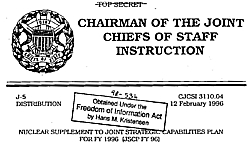 |
|
|
This broadening probably reflects the efforts to expand strike planning beyond Russia with increased focus on China and regional states armed with weapons of mass destruction (WMD). A “notable change” for the strike plan put in effect in March 2003 (OPLAN 8044 Revision 03) included executable strike options against regional states, options that were probably carried forward into the current OPLAN 8044 Revision 05.
Of course, Russia didn’t just disappear from the planning requirements. The NPR itself warned that although the country no longer is considered an immediate contingency, “Russia’s nuclear forces and programs, nevertheless, remain a concern. Russia faces many strategic problems around its periphery and its future course cannot be charted with certainty.” The NPR concluded that “U.S. planning must take this into account.” In addition, the NPR hedged, “in the event that U.S. relations with Russia significantly worsen in the future, the U.S. may need to revise its nuclear force levels and posture.” Relations have certainly not improved.
The previous JSCP-N from January 2000, which was updated in July 2001 (see here for chronology of nuclear guidance), required Defense Intelligence Agency (DIA) and Defense Information Systems Agency (DISA) to provide information to the Joint Staff for use in RISOP development. But the new JSCP-N moved this role to STRATCOM by directing that DIA and DISA “will support USSTRATCOM directly by providing data for red analysis.” The JSCP-N directs STRATCOM to perform three levels of analysis for the strike plans:
Phase I: Consequence of Execution Analysis
Phase II: Campaign Level Analysis
Phase III: Intelligence Assessment Analysis
Campaign Analysis is “a campaign level analysis to provide a stochastic check of the deterministic models used for the revision report consequences of execution analysis and to assess OPLAN 8044, REVISION XX’s [formerly SIOP] capability to comply with approved guidance. Such analysis will encompass various scenarios and may include the potential contribution of SACEUR’s MCOs [Major Combat Operations] as required.”
Despite the cancellation of RISOP, a 2004 STRATCOM briefing stated, STRATCOM “will continue to produce RISOP-like analysis,” and “procedures for requesting data and providing products will remain the same.” As before, use of the data will support prelaunch survivability analysis for ICBMs and bombers, base survivability of SSBN bases, and command, control and communication vulnerability and survivability analysis. All to ensure that U.S. nuclear forces will survive and endure against any nuclear adversary, including Russia.
Comments
U.S. nuclear forces were placed on high alert to counter the Soviet nuclear threat, and the effectiveness of the strike plan for their potential use continuously refined and improved by wargaming it against the RISOP. Now that Russia is not considered a nuclear threat and the RISOP has been canceled, how long will it be before the alert posture is canceled as well?
The U.S. strategic war plan – OPLAN 8044 Revision 05 – is currently structured around a reduced but more flexible posture with the same overall Triad structure as during the Cold War and over 1,000 nuclear warheads on high alert. Surprisingly, although RISOP was canceled in 2005, no revision has been made to OPLAN 8044 since October 2004 – the first time in U.S. post-Cold War nuclear history that the nation’s strategic war plan has not been overhauled at least once per year (see Figure 3).
|
Figure 3: |
 |
| STRATCOM has not published an updated U.S. strategic war plan since October 2004, breaking with a historical pattern of annual overhauls. The change probably reflects development of a new plan structure and more flexible adaptive planning capabilities. |
.
The explanation might be that major overhauls are no longer necessary because today’s plan has become flexible enough to accommodate changes on a ongoing basis without a need for a new revision; a “living SIOP.” OPLAN 8044 now consists of a family of plans applicable in a wider range of scenarios, with more flexible options to defeat adversaries in a wider range of contingencies than during the Cold War. Cancellation of RISOP might have reduced the focus on Russia, but it was also part of a broadening of nuclear strike planning to other potential adversaries.
The s l o w cancellation of the Russian-focused RISOP and the continuation of RISOP-like and red nuclear war planning for a broader and more flexible war plan should be an important lesson for the next president: unless he keeps his eye on the issue and pays continuous attention to how and when the military translates his initial guidance into a myriad of war planning requirements and strike options, the future U.S. nuclear posture – and with it the hope of significantly reducing the role and salience of nuclear weapons in the world – will only change v e r y slowly and not necessarily in the direction he had intended.
Chinese Nuclear Notebook Published
 A new Nuclear Notebook on Chinese nuclear forces has been published in the Bulletin of the Atomic Scientists. The notebook provides an unofficial overview of China’s nuclear-capable missiles, submarines and aircraft based on analysis done by Robert S. Norris (NRDC) and myself of Chinese and U.S. government documents, media reports, and other publications.
A new Nuclear Notebook on Chinese nuclear forces has been published in the Bulletin of the Atomic Scientists. The notebook provides an unofficial overview of China’s nuclear-capable missiles, submarines and aircraft based on analysis done by Robert S. Norris (NRDC) and myself of Chinese and U.S. government documents, media reports, and other publications.
The full article (PDF format) can be downloaded from here.
NPT 40 Years Later and Beyond
On July 1, 1968 the Treaty on the Non-Proliferation of Nuclear Weapons (NPT) was opened for signature, codifying for the first time a legally binding obligation to achieve nuclear disarmament. This year marks the 40th anniversary of this historic arms control treaty, to which every state in the United Nations except three has been a party (India, Pakistan, and Israel have never been signatories – North Korea withdrew from the Treaty in 2003).
Much has been written about whether the NPT regime is failing, in need of revision, or simply outdated. The NPT regime faces many challenges: nuclear weapons now enjoy a prominent place in the security policies of nuclear weapon states and new plans have been designed for their use including preemptive and preventive actions; materials and technology obtained from the civilian nuclear cooperation promoted by the Treaty could be used to manufacture nuclear bombs; a black market in nuclear technology and materials has been discovered; and the global rise in energy demand has put nuclear energy into the mix of solutions to this emerging crisis, despite the proliferation risks associated with advanced fuel cycle technology. Some voices counter that, with very few exceptions, the principles of the Treaty have prevented the widespread proliferation of nuclear weapons envisaged in the 1960’s by President Kennedy. One thing is clear: renewed commitment from the highest levels of government will be necessary to achieve the goals of the NPT and enable the processes and norms associated with the Treaty to peacefully navigate through the challenges it is facing and maintain its relevance for the future. (more…)
Dutch Government Rejects Blue Ribbon Review Findings
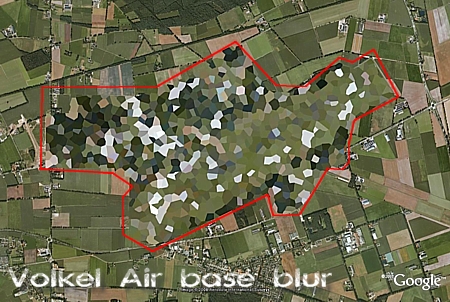 |
| The nuclear base at Volkel is pixeled out on Google Earth (why, Google?). Click on image to download map of the base (note: 1 MB). Image: GoogleEarth (outline and label added) |
.
By Hans M. Kristensen
The Dutch Government today rejected the findings of the U.S. Air Force’s Blue Ribbon Review, saying the safety and security at the nuclear weapons base at Volkel Air Base in the Netherlands “are in good order.”
The Blue Ribbon Review final report in February concluded that “most” nuclear sites in Europe do not meet U.S. safety requirements and that it would take “significant additional resources” to bring them up to standard. The disclosure of the findings has led to calls in some European countries that the remaining tactical nuclear weapons should be withdrawn.
During a meeting earlier today in the Defense Committee of the Dutch Parliament, Defense Minister Eimert van Middelkoop responded to a question from Krista van Velzen (Socialist Party) about the findings of the Blue Ribbon Review:
“Ms. van Velzen asked a question about the American report concerning the storage of nuclear weapons and Volkel. Insofar as this is relevant, safety and security at Volkel are in good order, but the government of the Netherlands does not make any announcements concerning the presence or absence of nuclear weapons embodying that single Dutch nuclear mission.” (unofficial translation)
|
Figure 1: |
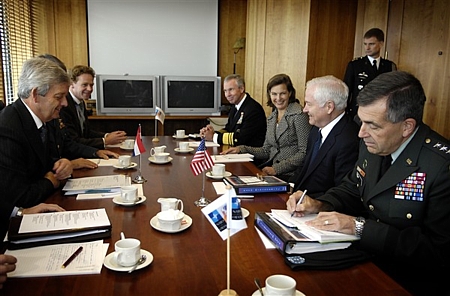 |
| Dutch Defense Minister Eimert van Middelkoop (left) met with U.S. Defense Secretary Robert Gates in October 2007. Afghanistan was on the agenda, but isn’t it time to talk about the withdrawal of U.S. nuclear weapons from Europe? |
.
Although Mr. Middelkoop refused to confirm or deny whether there are nuclear bombs at the base, he did confirm that the Netherlands still has a nuclear mission. It would have been more interesting to hear his explanation for why that mission is still needed. The enemy is gone, the weapons would take “months” to ready for strike, and the U.S. Air Force would like to see the weapons withdrawn. The deployment increasingly looks like nuclear social welfare for a small group of NATO bureaucrats.
There are an estimated 10-20 U.S. B61 nuclear bombs stored at Volkel Air Base for delivery by Dutch F-16 fighter jets, part of an arsenal of approximately 200 nuclear bombs at six bases in five European countries.
Previous reports: USAF Report: “Most” Nuclear Sites in Europe do not Meet US Security Requirements (FAS, June 2008) | U.S. Nuclear Weapons Withdrawn From the United Kingdom (FAS, June 2008) | United States Removes Nuclear Weapons from German Base, Documents Indicate (FAS, July 2007) | U.S. Nuclear Weapons in Europe (NRDC, 2005)
U.S. Nuclear Weapons Withdrawn From the United Kingdom

More than 100 U.S. nuclear bombs have been withdrawn from RAF Lakenheath, the forward base of the U.S. Air Force 48th Fighter Wing. Image: GoogleEarth
The United States has withdrawn nuclear weapons from the RAF Lakenheath air base 70 miles northeast of London, marking the end to more than 50 years of U.S. nuclear weapons deployment to the United Kingdom since the first nuclear bombs first arrived in September 1954.
The withdrawal, which has not been officially announced but confirmed by several sources, follows the withdrawal of nuclear weapons from Ramstein Air Base in Germany in 2005 and Greece in 2001. The removal of nuclear weapons from three bases in two NATO countries in less than a decade undercuts the argument for continuing deployment in other European countries.
Status of European Deployment
I have previously described that President Bill Clinton in November 2000 authorized the Pentagon to deploy 110 nuclear bombs at Lakenheath, part of a total of 480 nuclear bombs authorized for Europe at the time.

US Nuclear Weapons in Europe 2008
President George Bush updated the authorization in May 2004, which apparently ordered the withdrawal of nuclear weapons from Ramstein Air Base in Germany. The withdrawal from Lakenheath might also have been authorized by the Bush directive, or by an update issued within the past three years. This reduction and consolidation in Europe was hinted by General James Jones, the NATO Supreme Commander at Europe at the time, when he stated in a testimony to a Belgian Senate committee: “The reduction will be significant. Good news is on the way.”
Last week I reported that security deficiencies found by the U.S. Air Force Blue Ribbon Review at “most” sites were likely to lead to further consolidation of the weapons, and that “significant changes” were rumored at Lakenheath.

Withdrawal of U.S. nuclear weapons from three European bases since 2001 means that two-thirds of the arsenal is now on the southern flank.
The withdrawal from Lakenheath means that the U.S. nuclear weapons deployment overseas is down to only two U.S. Air Force bases (Aviano AB in Italy and Incirlik in Turkey) plus four other national European bases in Belgium, Germany, Holland and Italy, for a total of six bases in Europe. It is estimated that there are 150-240 B61 nuclear bombs left in Europe, two-thirds of which are based on NATO’s southern flank (see Table 1).
Some Implications
Why NATO and the United States have decided to keep these major withdrawals secret is a big puzzle. The explanation might simply be that “nuclear” always means secret, that it was done to prevent a public debate about the future of the rest of the weapons, or that the Bush administration just doesn’t like arms control. Whatever the reason, it is troubling because the reductions have occurred around the same time that Russian officials repeatedly have pointed to the U.S. weapons in Europe as a justification to reject limitations on Russia’s own tactical nuclear weapons.
In fact, at the very same time that preparations for the withdrawal from Ramstein and Lakenheath were underway, a U.S. State Department delegation visiting Moscow clashed with Russian officials about who had done enough to reduce its non-strategic nuclear weapons. General Jones’ “good news” could not be shared.
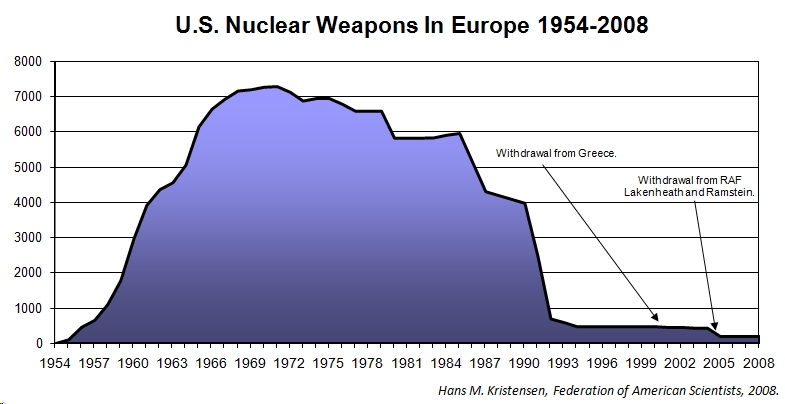
While NATO boasts about its nuclear reductions since the Cold War, the Alliance is more timid about the reductions in recent years.
By keeping the withdrawals secret, NATO and the United States have missed huge opportunities to engage Russia directly and positively about reductions to their non-strategic nuclear weapons, and to improve their own nuclear image in the world in general.
The news about the withdrawal from Lakenheath comes at an inconvenient time for those who advocate continuing deployment of U.S. non-strategic nuclear weapons in Europe. By following on the heels of the withdrawal from Ramstein Air Base in 2004-2005 and Greece in 2001, the Lakenheath withdrawal raises the obvious question at the remaining nuclear sites: If they can withdraw, why can’t we?
What is at stake is not whether NATO should be protected with nuclear weapons, but why it is still necessary to deploy tactical nuclear weapons in Europe. Japan and South Korea are also covered by the U.S. nuclear umbrella, but without tactical nuclear weapons deployed in Asia. The benefits from withdrawing the remaining non-strategic nuclear weapons from Europe far outweigh the costs, risks and political objectives of keeping them there. The only question is: who will make the first move?
Previous reports: USAF Report: “Most” Nuclear Sites in Europe do not Meet US Security Requirements (FAS, June 2008) | United States Removes Nuclear Weapons from German Base, Documents Indicate (FAS, July 2007) | U.S. Nuclear Weapons in Europe (NRDC, 2005)
USAF Report: “Most” Nuclear Weapon Sites In Europe Do Not Meet US Security Requirements
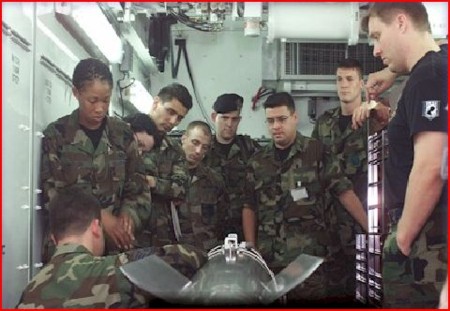 |
| Members of the 704 Munition Support Squadron at Ghedi Torre in Italy are trained to service a B-61 nuclear bomb inside a Munitions Maintenance Truck. Security at “most” nuclear bases in Europe does not meet DOD safety requirements, a newly declassified U.S. Air Force review has found. Withdrawal from some is rumored. Image: USAF |
.
By Hans M. Kristensen [article updated June 26 following this report]
An internal U.S. Air Force investigation has determined that “most sites” currently used for deploying nuclear weapons in Europe do not meet Department of Defense security requirements.
A summary of the investigation report was released by the Pentagon in February 2008 but omitted the details. Now a partially declassified version of the full report, recently obtained by the Federation of American Scientists, reveals a much bigger nuclear security problem in Europe than previously known.
As a result of these security problems, according to other sources, the U.S. plans to withdraw its nuclear custodial unit from at least one base and consolidate the remaining nuclear mission in Europe at fewer bases.
European Nuclear Safety Deficiencies Detailed
The national nuclear bases in Europe, those where nuclear weapons are stored for use by the host nation’s own aircraft, are at the center of the findings of the Blue Ribbon Review (BRR), the investigation that was triggered by the notorious incident in August 2007 when the U.S. Air Force lost track of six nuclear warheads for 36 hours as they were flow across the United States without the knowledge of the military personnel in charge of safeguarding and operating the nuclear weapons.
|
Figure 1: |
 |
|
“Most” nuclear sites in Europe don’t meet DOD security standards, according to the Blue Ribbon Review report. |
The final report of the investigation – Air Force Blue Ribbon Review of Nuclear Weapons Policies and Procedures – found that “host nation security at overseas nuclear-capable units varies from country to country in terms of personnel, facilities, and equipment.” The report describes that “inconsistencies in personnel, facilities, and equipment provided to the security mission by the host nation were evident as the team traveled from site to site….Examples of areas noted in need of repair at several of the sites include support buildings, fencing, lighting, and security systems.”
The situation is significant: “A consistently noted theme throughout the visits,” the BRR concluded, “was that most sites require significant additional resources to meet DOD security requirements.” Despite overall safety standards and close cooperation and teamwork between U.S. Air Force personnel and their host nation counterparts, the inspectors found that “each site presents unique security challenges.”
Specific examples of security issues discovered include conscripts with as little as nine months active duty experience being used protect nuclear weapons against theft.
Inspections can hypothetically detect deficiencies and inconsistencies, but the BRR team found that U.S. Air Force inspectors are hampered in performing “no notice inspections” because the host nations and NATO require advance notice before they can visit the bases. If crews know when the inspection will occur, their performance might not reflect the normal situation at the base.
Many of the safety issues discovered are precipitated by the fact that the primary mission of the squadrons and wings is not nuclear deterrence but real-world conventional operations in support of the war on terrorism and other campaigns. This dual-mission has created a situation where many nuclear positions are “one deep,” and where rotations, deployments, and illnesses can cause shortfalls.
The review recommended consolidating the bases to “minimize variances and reduce vulnerabilities at overseas locations.”
USAFE Commander Visits Nuclear Bases
In light of the findings about Air Force nuclear security, General Roger Brady, the USAFE Commander, on June 11 visited Kleine Brogel Air Base in Belgium and Volkel Air Base in Holland. Both bases store U.S. nuclear weapons for delivery by their national F-16 fighters.
.
A news story on a USAF web site notes that the weapons security issues found by the BRR investigation were “at other bases,” suggesting that Büchel Air Base in Germany or Ghedi Torre Air Base in Italy were the problem. Even so, the BRR found problems at “most sites,” visits to Kleine Brogel and Volkel were described in the context of these findings. Two commanders of the 52 Fighter Wing at Spangdahlem Air Base, which controls the 701st and 703rd Munitions Support Squadrons at the national bases, were also present “to witness both units for the first time.”
Withdrawal and Consolidation
The deficiencies at host nation bases apparently have triggered a U.S. decision to withdraw the Munition Support Squadron (MUNSS) from one of the national bases.
Four MUNSS are currently deployed a four national bases in Europe: the 701st MUNSS at Kleine Brogel Air Base in Belgium, the 702nd MUNSS at Büchel Air Base in Germany, the 703rd MUNSS at Volkel Air Base in Holland, and the 704th MUNSS at Ghedi Torre in Italy (see top image).
It is not yet known which base it is, but sources indicate that it might involve the 704th MUNSS at Ghedi Torre in Northern Italy.
Status of Nuclear Weapons Deployment [June 26: warhead estimate updated here]
The number and location of nuclear weapons in Europe are secret. However, based in previous reports, official statements, declassified documents and leaks, a best estimate can be made that the current deployment consists of approximately 150-240 B61 nuclear bombs (see update here). The most recent public official statement was made by NATO Vice Secretary General Guy Roberts in an interview with the Italian RAINEWS in April 2007: “We do say that we’re down to a few hundred nuclear weapons.”
|
Table 1: |
 |
|
Derived from more extensive table. Click table or here to download the full table. |
The U.S. weapons are stored in underground vaults, known as WS3 (Weapon Storage and Security System), at bases in Belgium, Germany, Holland, Italy, and Turkey. Most of the weapons are at U.S. Air Force bases, but Belgium, Germany, Holland and Italy each have nuclear weapons at one of their national air bases.
The weapons at each of the national bases are under control of a U.S. Air Force MUNSS in peacetime but would, upon receipt of proper authority from the U.S. National Command Authority, be handed over to the national Air Force at the base in a war for delivery by the host nation’s own aircraft. This highly controversial arrangement contradicts both the Non-Proliferation Treaty and NATO’s international nonproliferation policy.
Implications and Observations
The main implication of the BRR report is that the nuclear weapons deployment in Europe is, and has been for the past decade, a security risk. But why it took an investigation triggered by the embarrassing Minot incident to discover the security problems in Europe is a puzzle.
Since the terrorist attacks in September 2001, billions of dollars have been poured into the Homeland Security chest to increase security at U.S. nuclear weapons sites, and a sudden urge to improve safety and use control of nuclear weapons has become a principle justification in the administration’s proposal to build a whole new generation of Reliable Replacement Warheads.
But, apparently, the nuclear deployment in Europe has been allowed to follow a less stringent requirement.
This contradicts NATO’s frequent public assurances about the safe conditions of the widespread deployment in Europe. Coinciding with the dramatic reduction of nuclear weapons in Europe after the Cold War 15 years ago, “a new, more survivable and secure weapon storage system has been installed,” a NATO fact sheet from January 2008 states. “Today, the remaining gravity bombs associated with DCA [Dual-Capable Aircraft] are stored safely in very few storage sites under highly secure conditions.”
Apparently they are not. Yet despite the BRR findings, the NATO Nuclear Planning Group meeting in Brussels last week did not issue a statement. But at the previous meeting in June 2007 the group reaffirmed the “great value” of continuing the deployment in Europe, “which provide an essential political and military link between the European and North American members of the Alliance.”
That NATO – nearly two decades after the Cold War ended – believes it needs U.S. tactical nuclear weapons in Europe to keep the alliance together is a troubling sign. NATO air forces are stretched thin to meet real-world operations in the war against terrorism and other campaigns, and tactical nuclear weapons are not a priority, no matter what nuclear bureaucrats might claim.
Even Republican presidential candidate John McCain apparently does not believe tactical nuclear weapons in Europe are essential for NATO. On May 27 he stated that, if elected, he would, “in close consultation with our allies…like to explore ways we and Russia can reduce – and hopefully eliminate – deployments of tactical nuclear weapons in Europe.”
Many European governments would support such a plan – even though some of the new eastern European NATO members see Russian resurgence as a reason to continue the deployment. But their security concerns can be met by other means, and Germany and Norway have already been pushing a proposal inside NATO for a review of the alliance’s nuclear policy, the Belgium parliament has called for a withdrawal, and there is overwhelming cross-political public support in Germany to end the deployment in Europe.
Perhaps the BRR findings will help empower these countries and convince NATO and the next U.S. administration that the time has come to finally complete the withdrawal of tactical nuclear weapons from Europe.
Additional Information: Blue Ribbon Review (2008 report) | United States Removes Nuclear Weapons From German Base, Documents Indicate (2007 report) | US Nuclear Weapons in Europe (2005 report)
Extensive Nuclear Missile Deployment Area Discovered in Central China
 |
| More than 50 launch pads for nuclear ballistic missiles have been identified scattered across a 2,000 square kilometer (772 square miles) area of central China, according to analysis of satellite images. Click image for full size. Also download GoogleEarth KMZ file. |
.
By Hans M. Kristensen
Analysis of new commercial satellite photos has identified an extensive deployment area with nearly 60 launch pads for medium-range nuclear ballistic missiles in Central China near Delingha and Da Qaidam.
The region has long been rumored to house nuclear missiles and I have previously described some of the facilities in a report and a blog. But the new analysis reveals a significantly larger deployment area than previously known, different types of launch pads, command and control facilities, and missile deployment equipment at a large facility in downtown Delingha.
The U.S. government often highlights China’s deployment of new mobile missiles as a concern but keeps the details secret, so the discovery of the deployment area provides the first opportunity for the public to better understand how China operates its mobile ballistic missiles.
Description of Deployment Area
The deployment area is located in the northern parts of the Qinghai province and consists of two areas west of Delingha and Da Qaidam. In total, 58 launch pads have been identified scattered over an area stretching roughly 275 kilometers (170 miles) along highway G315 leading from Delingha through Da Qaidam to Mahai (see banner image for details). Nearly all launch pads detected so far are located on the north side of the road. Combined, the deployment area covers approximately 772 square miles (2,000 square kilometers).
|
Figure 1: |
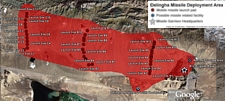 |
|
36 launch pads and the 812 Brigade Base have been identified in and around Delingha. Click on image to see full size |
The Delingha (德令哈) deployment area stretches approximately 52 kilometers (32 miles), covering 1,000 square kilometers (386 square miles) west of the city of Delingha (see Figure 1). A total of 36 launch pads have been identified along three side roads extending north from the main road. The three strings of launch pads are separated by 16-20 kilometers (10-12 miles). This area appears to be very active with missile operations detected in 2005 and 2007, and several facilities in downtown Delingha associated with missile operations are identified below.
|
Figure 2: |
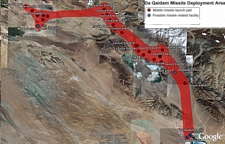 |
|
22 launch pads have been identified northwest of Da Qaidam. Click on image for full size |
The Da Qaidam deployment area stretches for more than 100 kilometers (62 miles) west of the city of Da Qaidam Zhen all the way past Mahai, covering an area of 1,100 square kilometers (424 square miles). A total of 22 launch pads have been identified alongside and to the north of the main road (see Figure 2). This deployment area shows clear wheel tracks at several of the pads, including what might be construction of new pads or maintenance of existing ones. Unlike in Delingha, no missile related facilities have yet been identified in or around Da Qaidam itself, except for what appears to be a surface-to-air missile (SAM) site in the city itself and what might be a command and control facility further south near Xiao Qaidam.
There are probably more launch pads and facilities between Delingha and Mahai, but satellite photos of a couple of areas are not yet available on Google Earth.
From these launch pads DF-21 missiles would be within range of southern Russia and northern India (including New Delhi), but not Japan, Taiwan or Guam.
|
Figure 3: |
 |
|
Four basic launch pad designs have been detected ranging is size from 15-70 meters. |
Launch Pad Designs
The 58 launch pads include four basic designs: a 70-meter full circle; a 40-meter T-shape, a 15-45 meter rectangular, and a 30-meter pull-out (see Figure 3). The 15-meter rectangular is by far the most common design. There are two full circle pads and four T-shape pads.
The large circular pads are probably older designs for the liquid-fuel DF-3 and DF-4, which require a large number of fuel trucks on the pad until shortly before launch. The liquid-fuel missiles are now being phased out and replaced with the solid-fuel DF-21 and DF-31, which require fewer support vehicles. The DF-31 has not been reported in the Delingha and Da Qaidam areas, but its smaller predecessor the DF-21 has deployed there for several years and can be launched from the small 15-meter pads. Two of the pads in Figure 3 show what are estimated to be DF-21 launchers, a 2006 deployment previously described here.
The pads could potentially also be used by short-range missiles such as the DF-11 and DF-15. But the DOD has repeatedly stated in its annual reports on China’s military that “all of [China’s] SRBM units are deployed to locations near Taiwan.”
Several of the smaller 15-meter launch pads appear to have a small infrastructure consisting of a tiny building located approximately 150 meters from the pad. A few also have larger structures nearby.
Command and Control Facilities
The satellite photos also show what appear to be buried command and control (C2) facilities at each deployment area. They are hard to find because they blend in with the other pads, but a closer look reveals that they are very different and so far two have been detected (see Figure 4).
The two C2 facilities have the same dimensions, 20 x 16 meters, and each has a tall antenna at either end of what looks like a concrete pad. The pads might cover buried facilities used for C2, or be used by C2 vehicles that deploy with the missile launcher.
The facilities face the same direction, and lines drawn from each antenna parallel to the end of the facilities run through Delingha as well as Wulan (Ulan) further to the southeast, a rumored location of the headquarters for the missiles in this area.
|
Figure 4: |
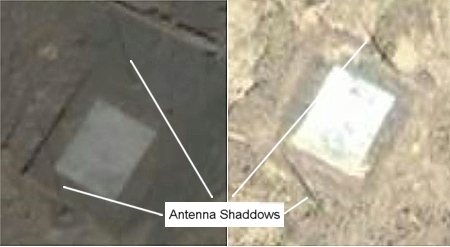 |
| Two of the pads (sites A4 and D1) have twin antennae and appear to be command and control facilities. |
.
Likewise, a string of facilities with antennae south of Da Qaidam near Xiao Qaidam might also be related to command and control operations.
Missile Activities Downtown Delingha
Traveling through Delingha a few years ago, a group of hikers described the encounter: “While trying to find accommodation we got stopped by police, one of them did some cell phoning and then offered to find a hotel for us, we were impressed! Once in the hotel there was a knock on the door- and we were confronted with ‘Alien Police’ who informed us we were in a closed city where no foreigners were allowed.”
Whether the hikers were deported because Delingha houses a nuclear missile brigade is unknown, but in the past it has been difficult to identify facilities in the city related to missile operations. A satellite photo taken on February 28, 2008, however, shows structures similar to those observed on remote launch pads outside the city in 2005 and 2006. The structures can be seen at three locations inside a 1.5 x 0.5 kilometer (0.7 x 0.3 mile) compound (see Figure 5), and appear to reveal the location of the 812 Brigade Base Headquarters for the first time.
|
Figure 5: |
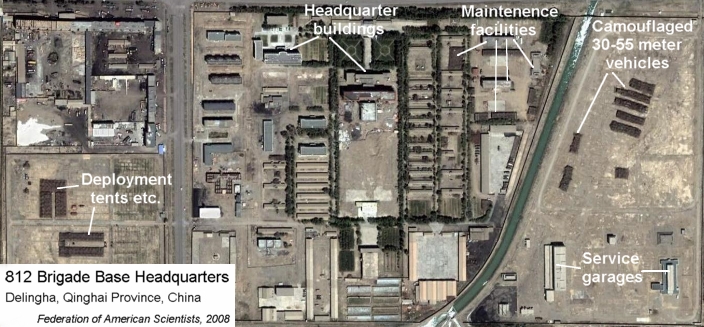 |
| Missile related facilities and equipment reveal the location of the 812 Brigade Base in downtown Delingha. Click on the image for full size. |
.
A square fenced section in the western part of the base compound is dominated by two large c-shaped structures. Closer inspection reveals that they consist of five tent-like structures, two of which are about 70 meters long and three that are 40 meters. At the end of the two larger tents is what appears to be a gate or portal. Next to the tents are two small buildings and a truck (see Figure 6).
|
Figure 6: |
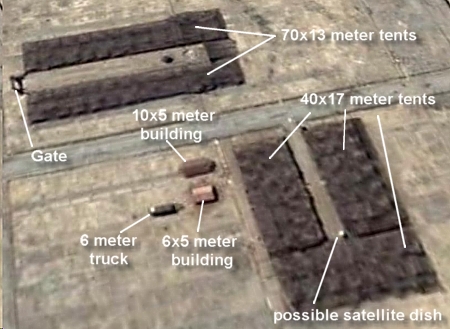 |
| Tent-like structures visible in downtown Delingha appear to be used by the missile launch brigade when it deploys to remote launch pads (see also Figure 7). |
.
These structures are hard to identify by themselves, but when comparing with earlier satellite photos from the same area they become significant because they are very similar – if not identical – to structures seen on dispersed launch pads near Delingha in 2005 and 2006. Two of those cases are reproduced in Figure 7, showing an 80-meter tent, 43 crew tents/huts, a gate, and six fuel trucks at Launch Pad B1 in 2005, as well as a DF-21 launcher with a crew tent/hut at Launch Pad B10 in 2006.
|
Figure 7: |
 |
| Tent-like structures similar to the ones detected in downtown Delingha (see Figure 6) were deployed to missile launch pads in 2005 (right) and 2006. |
.
At the eastern end of the compound is another large open facility with what appears to be camouflage nets covering unidentified vehicles. The relatively low resolution of the photos conceal many details, and it’s difficult to say whether they are vehicles or stacked equipment, how long they have been there, and whether they’ve just arrived or are being shipped out. Yet their sizes (27-56 meters) and shapes are particularly interesting because the length of the DF-21 launcher is approximately 13 meters and the DF-31 launcher is about 23 meters. At the south end of this facility are two large buildings that might be service garages for missile launchers (see Figure 8).
|
Figure 8: |
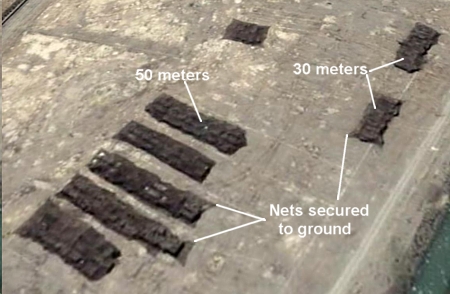 |
| Equipment similar in size to launch platforms is covered by camouflage nets. Two buildings at the south end of the facility resemble service buildings for launchers. |
.
Immediately to the west of this facility, separated by a canal, a triangle-shaped section of the main compound appears to be associated with servicing the missile units and their equipment. Clearly visible are several tents of the same basic design as those seen in the western facility and on launch pads, as well as three smaller huts and the shadow of what seems to be a gate/portal (see Future 9).
|
Figure 9: |
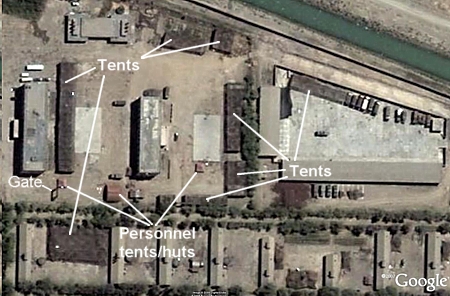 |
| Tent-like structures, red huts, and a gate/portal similar to those observed at launch sites B1 and B5 in 2005 and 2006 identify this section of the Delingha base as a possible service facility for mobile ballistic missile launchers. |
.
Implications of a Mobile Missile Force
The current head of China’s Second Artillery Corps, General Jing Zhiyuan, reportedly served as commander of the Second Artillery Base 56 in Xining, the headquarters for the Delingha missile brigade, from 1993 to 1997. As such he would have overseen the preparations for the transitioning from old liquid-fuel missiles at Delingha and Da Qaidam to solid-fuel missiles.
This change, one all the other nuclear powers made decades ago, is in full swing through the Chinese missile force. Several of the small pads detected at Delingha and Da Qaidam have been added since 2005. At that time approximately 33 of China’s deployed 91 ballistic missiles were solid-fuel, corresponding to 36 percent. Today the share is 67 out of 121 deployed missiles, or 55 percent. The share will increase in the next several years as more DF-31s and DF-31As are deployed and the DF-3As and DF-4s are retired. JL-2 missiles on Jin-class submarines will increase the percentage even more.
Similarly to the other nuclear weapon states, China is trying to reduce the vulnerability of its nuclear deterrent, and much of the debate about the new mobile missiles centers on their ability to disperse and launch quickly, making them harder for others to destroy. The small 15-meter launch pads are indeed easy to overlook compared with the larger 70-meter pads, and it is not known which of he pads will be used by launchers in a war; they might even be capable of launching from the main road. The tire tracks visible in the images and the absence of paved roads to most of the launch pads suggest the DF-31 launchers have some off-road capability.
Even so, the relatively low-resolution satellite images show that even mobile missile leave fingerprints such as tire tracks and rely on a highly visible infrastructure that includes the launch pads themselves, command and control facilities, and bases. Moreover, targeting Chinese mobile systems is far from a new and untested challenge for U.S. military planners because China and Russia have deployed – and the United States has routinely targeted – their mobile ballistic missiles since the early 1980s. Indeed, the DOD’s determination that all of China’s smallest mobile missile units – those that are hardest to detect and the most numerous – are confined to one region and nowhere else in this vast country suggests that a considerable detection (and thus targeting) capability exists today.
Mobile missiles might make it more difficult to carry out a successful first strike to destroy all of the launchers, but it doesn’t make the force invulnerable. If hidden inside a cave it is relatively simple to seal off the entrance and trap the launchers inside. Once out in the open mobile launchers can move and try to hide, but they are highly vulnerable to the blast effect of a nuclear weapon. The specific targeting and damaging requirements for U.S. nuclear forces tasked with targeting Chinese mobile missiles are not know. But the following excerpt from The U.S. Nuclear War Plan: A Time For Change (NRDC 2001, p. 54) about targeting Russian mobile SS-25 ICBMs might be a good illustrative example for targeting Chinese mobile missiles as well:
| “The 1969 Defense Intelligence Agency Physical Vulnerability Handbook—Nuclear Weapons assigns a vulnerability number of 11Q9 to road-mobile missiles with ranges of 700, 1,100, and 2,000 nautical miles or with intercontinental ranges. The damage level for this vulnerability number is defined as “transporter overturned and missile crushed.” The kill mechanism has been likened to flipping a turtle on its back. For a 100-kt weapon [the W76], the optimum height of burst to attack a target with a vulnerability number of 11Q9 is approximately 1,250 m (no local fallout would be expected), and the corresponding damage radius is 2,875 m. Thus dispersed SS-25 vehicles can be threatened over an area of approximately 26 square kilometers by a single W76 air burst. If, for example, a MAZ vehicle is traveling at 20 kilometers per hour, then one W76 explosion must occur within about 15 minutes of noting the location of the moving vehicle. While this time interval is roughly consistent with depressed-trajectory launches of SLBMs, it would require additional time to communicate the SS-25 locations to the SSBNs and retarget the missiles. The fact that Trident I or Trident II SLBMs are MIRVed, with up to eight [now estimated to be six] warheads per missile, means that a group of moving SS-25 launcher vehicles could also be pattern-attacked with W76 warheads over an area of some 200 square kilometers.” |
.
Using this example as a guide, it would require at least 24 100-kiloton W76 warheads – the load of four Trident II D5 missiles – detonating at a height of burst of 1,250 meters to ensure destruction of all the 58 launch pads identified in these satellite images, plus several more warheads to destroy the bases. Rather than aiming at each pad, warfighters would more likely try to hit the launchers before they dispersed.
The mobile nuclear cat and mouse game is on: Chinese planners are trying to hide and U.S. and Russian planners are trying to catch them.
Additional information: Chinese Nuclear Forces and U.S. Nuclear War Planning | GoogleEarth KMZ File
Nukes in the Taiwan Crisis
.
By Hans M. Kristensen
Thanks to the efforts of Bill Burr at the National Security Archive, some of the veil covering U.S. nuclear war planning against China in the 1958 Taiwan Strait crisis now has been lifted by a declassified military study.
It shows that on the day after the Chinese began shelling the Quemoy islands on August 23, 1958, U.S. Air Force Headquarters apparently assured Pacific Air Forces “that, assuming presidential approval, any Communist assault upon the offshore islands would trigger immediate nuclear retaliation.” Yet President Dwight D. Eisenhower fortunately rejected the use of nuclear weapons immediately, even if China invaded the islands, and emphasized that under no circumstances would these weapons be used without his approval.
Caution against nuclear use didn’t mean not planning for it, however, and in the years after the Taiwan Strait crisis an enormous nuclear build-up occurred in the Far East. The numbers started to decline in the 1970s, and for a period during the 1980s and first half of the 1990s, nuclear planning against China was reduced to reserve force contingencies. In the past decade, however, China has again become a focus for U.S. nuclear strike planning.
The Available Nuclear Bombs
Shortly after the Chinese shelling of Quemoy began, General Nathan Twining, the Chairman of the Joint Chiefs of Staff, explained during a meeting with President Eisenhower’s cabinet that U.S. aircraft at the outset would drop 10-15 kilotons nuclear bombs on selected fields in the vicinity of Amoy (Xiamen). The Pacific Air Forces drew up a contingency plan based on the assumption that the United States would carry out the nuclear strikes necessary to defeat the attacking Chinese forces.
At that time, the Matador nuclear cruise missile was already deployed in Taiwan. The missile could deliver a 20 kt W5 warhead to a range of about 965 km (600 miles). From Taiwan, the Matador could potentially have hit Chinese troop concentrations around Amoy, but General Twining apparently favored bombs. Nuclear bombs, however, did not arrive in Taiwan until January 1960, but a declassified document previously released to me under FOIA shows they were available on Guam and Okinawa. The bombs included three types – Mk-6 (only Guam), Mk-36 Mod 1, and Mk-39 Mod 0 – with yields ranging from 8 kilotons to 10 megatons (see Table 1).
| Table 1: Nuclear Bombs Deployed Near Taiwan, June 1958 |
|||
| Base | Bomb Type | Yield(s) | Custodian Unit |
| Anderson AFB, Guam |
Mk-6 Mk-36 Mod 1 Mk-39 Mod 0 |
8, 22, 61, 160 kt 10,000 kt ~3,750 kt |
3 ADS |
| Kadena AB, Okinawa | Mk-6 Mk-39 Mod 0 |
8, 22, 61, 160 kt ~3,750 kt |
12 ADS |
| Sources: U.S. Strategic Air Command, History of the Strategic Air Command 1 January 1958 – 30 June 1958, Historical Study Number 73, Volume 1, n.d. [1959] p. 89. Document obtained under FOIA; Chuck Hansen, Swords of Armageddon, Version 2, 2002. (Table corrected October 21, 2008) |
|||
.
The Mk-6 was a tactical bomb that could be delivered in a ground or airburst mode by a variety of Air Force and Navy aircraft and probably would have been the weapon of choice for the Taiwan scenario. The Mk-36 and Mk-39 were both strategic megaton weapons more suited for use against large area targets such as cities or to “dig up” underground facilities.
In mid-August, five Strategic Air Command B-47 bombers on Guam were put on alert to conduct nuclear strikes against airfields on the Chinese mainland if necessary. Such attacks would be necessary, General Twining said, if initial nuclear strikes against troop concentrations failed to cause China to lift their blockade of Quemoy.
|
Figure 1: |
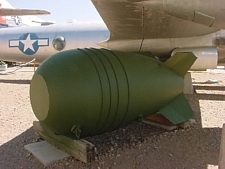  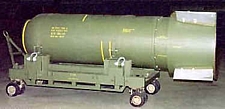 |
|
At the time of the 1958 Taiwan Strait crisis, US Strategic Air Command deployed Mk-6, Mk-36 and Mk-39 (top down) nuclear bombs on Guam and Okinawa (only Mk-36 and 39). |
The Nuclear Posture After The Taiwan Crisis
Fortunately the general didn’t have his way and the declassified study obtained by Burr concludes that the “principal question” raised by the crisis was: “Would the American military in future crises encounter cautious presidential control over nuclear weapons?” Fortunately it did, but although this reality caused the military to focus more on non-nuclear warfare, it did little to stem the forward deployment of large numbers of nuclear weapons to Northeast Asia at the time.
In South Korea, a few months before the Taiwan Strait crisis erupted, deployment of six U.S. nuclear weapon systems was already underway: the Honest John surface-to-surface missile; the Matador cruise missile; the Atomic-Demolition Munition (ADM) nuclear landmine; the 280-mm gun; the 8-inch (203mm) howitzer; and nuclear bombs for fighter bombers. After the Taiwan Strait crisis cooled down, five more nuclear weapon systems arrived in South Korea: the surface-to-surface missile systems Lacrosse, Davy Crockett, and Sergeant; the dual-mission Nike Hercules anti-air and surface-to-surface missile; and finally the 155-mm Howitzer. At the peak of the build-up in 1967, nearly 950 warheads were deployed in South Korea.
Nuclear weapons also were deployed to Taiwan. As mentioned above, the Matador cruise missile was already present on the island when the Taiwan Strait crisis erupted. The nuclear bombs arrived in January 1960 and stayed for a decade and a half until July 1974. Together with nuclear bombs for tactical fighter wings deployed at Clark Air Base in the Philippines, Kusan Air Base in South Korea and Kadena Air Base on Okinawa, the nuclear bombs in Taiwan probably were intended for use against targets in China and North Korea.
The deployment to Taiwan was not without its problems: After a series of inspections of nuclear weapons facilities in the Far East, the U.S. Senate Foreign Relations Committee in 1970 sharply criticized the U.S. policy that guided the forward deployment as well as the agreements and understandings with the host country about the deployment, use, or withdrawal of these weapons. “One example: …the ranking United States Army officer in [Taiwan] testified he was not aware whether or not nuclear weapons were located on Taiwan.”
After the weapons were withdrawn from Taiwan in July 1974, the three other fighter wings in the Philippines, Okinawa and South Korea continued to be tasked under the SIOP (Single Integrated Operational Plan), the latter as a Quick Reaction Alert strike force. At that time the SIOP included four major attack options, two of which were against China, and three of 11 new Selected Attack Options directed by NUWEP-74 aimed at virtually all elements of Chinese military and industrial facilities.
In 1982, however, China was removed from SIOP planning to reflect the country’s new status as a U.S. partner against the Soviet Union. During this time, nuclear planning against China was confined to a small number of contingency options involving the strategic reserve force and non-strategic nuclear weapons. The Joint Strategic Capabilities Plan (JSCP) for Fiscal Year 1984, for example, did order the preparation of a Contingency Plan (CONPLAN) for the employment of nuclear weapons against China’s power projection capabilities (presumably ballistic missile and air bases). But this requirement was short lived and was dropped again in the FY85 JSCP.
Taiwan and China in Recent Nuclear Planning
Sixty years after the shelling of Quemoy islands, China and the Taiwan Strait remain a center for U.S. military planning and a potential trigger for a nuclear conflict between the United States and China. But with the glossy Soviet Military Power from the 1980s replaced by Military Power of the People’s Republic of China as the Pentagon’s most prominent unclassified annual threat report – and most U.S. ballistic missile submarines now patrolling in the Pacific instead of in the Atlantic as during the Cold War, and bomber squadrons periodically forward-deploying to Guam – China appears to have taken center stage.
The rise of China in recent U.S. nuclear planning occurred gradually in the 1990s after the Soviet Union fell apart and the Cold War faded. Coinciding with U.S. intelligence reports about China’s slow but steady modernization of long-range strategic nuclear forces, some military planners began arguing that it was necessary to begin to target China on a more ongoing and fundamental basis.
During the 1994 Nuclear Posture Review, STRATCOM and some DOD officials unsuccessfully lobbied for increasing nuclear planning against China. One example of this effort was STRATCOM’s Sun City Extended nuclear force structure study from 1994, which – unlike the Sun City study completed a year earlier – dedicated more than a dozen pages to analyzing China scenarios. It identified two: a US/North Korea/China excursion involving less than a full-scale attack against China; and a US/China confrontation involving a major-attack response plan (see Figure 2).
|
Figure 2: |
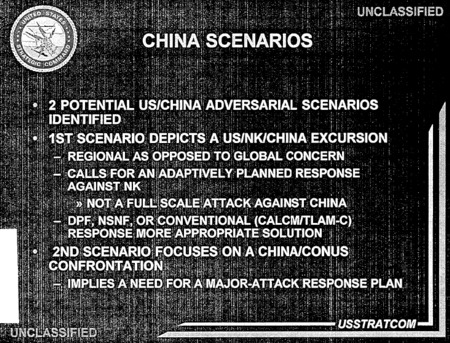 |
| A 1994 STRATCOM nuclear force structure study identified two China scenarios: one involving North Korea; and a direct US-China confrontation most likely over Taiwan. Document obtained under FOIA. |
.
Although advocates for a stronger focus on China failed to change policy in 1994, a new Taiwan Strait crisis in March 1996 provided new impetus after China test launched several short-range ballistic missiles from the mainland into the waters north and south of Taiwan (the northern impact area being only 19 miles from Chilung). The exercise was the latest and largest in a series of what U.S. Naval Intelligence considered to be rehearsals of a contingency scenario for the invasion of Taiwan, a new scenario first detected in 1994. The United States responded by sending two aircraft carrier battle groups to the area.
The following year, in October 1997, President Clinton signed Presidential Decision Directive (PDD)-60, which lowered the targeting requirement against Russia but reportedly at the same time broadened the spectrum of Chinese facilities that could be attacked with nuclear weapons to include the country’s growing military-industrial complex and improved conventional forces. Despite the implications, one official told Washington Post, there was “no debate with respect to the targeting of China.”
The language of PDD-60 was specific enough to allow STRATCOM to formally bring China back into SIOP planning after a hiatus of 16 years. A classified STRATCOM study from 1999 labeled China as “a growing force,” and one of STRATCOM’s first acts was to build the CHISOP, the Chinese Integrated Strategic Operations Plan, to “war game” that force against U.S. nuclear forces. CHISOP was similar to the RISOP (Red Integrated Strategic Operations Plan), a hypothetical Russian war plan that had existed for many years. But whereas China in RISOP was “war gamed” as part of the “blue force” against the Soviet Union and Russia, one effect of PDD-60 was that China in the planning became an independent “red force.” The CHISOP was intended to serve as a “single-point estimate” of Chinese strategic capabilities and potential employment by using available intelligence information about Chinese nuclear weapon systems, strategy, and policy in “war games” to assess the effectiveness of U.S. nuclear strike plans against China.
|
Figure 3: |
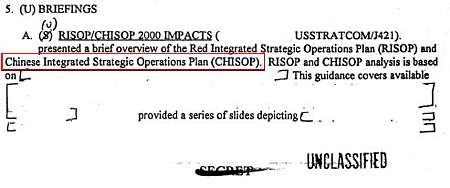 |
| Following President Clinton’s signing of PDD-60 in October 1997, which reportedly authorized a broadening of nuclear targeting against China, STRATCOM began designing CHISOP, the Chinese Integrated Strategic Operations Plan, a parallel to the RISOP (Russian Integrated Strategic Operations Plan) previously used to “war game” U.S. and Russian nuclear forces. Document obtained under FOIA. |
.
It was around this time that the Bush administration’s Nuclear Posture Review in late 2001 identified a military confrontation over the status of Taiwan as an “immediate contingency” influencing the sizing U.S. nuclear forces. China, due to its still evolving strategic objectives and ongoing modernization of nuclear and non nuclear forces, was described as a country that “could be involved in an immediate or potential contingency.”
Yet CHISOP appears to have been short lived, at least with that name. In early 2005, RISOP was canceled and with it, presumably, the efforts to build the CHISOP. The cancellation probably reflected a change in U.S. strategic war planning of which only little is known, coinciding with the publication of a new Nuclear Weapons Employment Policy (NUWEP) document in 2004 and a major revamping of the U.S. strategic nuclear war plan in October 2004 (OPLAN 8044 Revision 05). CHISOP and RISOP were probably incompatible with modern planning because they were products of the Soviet-focused planning for the SIOP, which has since been converted into a “family of plans applicable in a wider range of scenarios” with “more flexible options” against potential “adversaries in a wider range of contingencies.”
CHISOP or not, however, the March 2006 Quadrennial Defense Review underscored the central status of China in U.S. planning: “Of the major and emerging powers, China has the greatest potential to compete militarily with the United States” as it “continues to invest heavily in its military, particularly in its strategic arsenal and capabilities designed to improve its ability to project power beyond its borders.”
Additional information: Chinese Nuclear Forces and U.S. Strategic Nuclear War Planning | White House Guidance Led to New Nuclear Strike Plans Against Proliferators, Document Shows
Thinking Big on Uranium and Iran
Iran continues to enrich uranium. Enrichment is the process that makes natural uranium useable in a nuclear reactor or, if carried further, a nuclear bomb. Iran claims that the motivation for its enrichment program is entirely peaceful but almost no one outside of Iran believes this. With the United States shouting from the sidelines, the Europeans are continuing the hard diplomatic work of persuading Iran to suspend its enrichment program, with little success.
The Iranians claim that they have just as much right as anyone to enrich uranium for their civilian nuclear reactors. This is not true but it is not entirely wrong. Part of the reason for on-going sanctions is that they lied to the International Atomic Energy Agency (IAEA) for years. Iran could, in theory, make amends and satisfy the IAEA and then legally enrich uranium. Any country could. Enrichment, the process of preparing uranium for a nuclear reactor or, potentially, a nuclear weapon, is today a legitimate industrial enterprise. That is a problem.
The administration looks at the situation through the lens of an Iranian threat, but the problem is long-term, global, and fundamental. It is time to make a bold proposal that will apply to the Iranians but includes everyone else, even the United States. (more…)
Russian Nuclear Missile Submarine Patrols Decrease Again
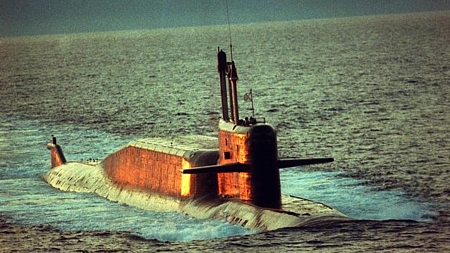
By Hans M. Kristensen
The number of deterrence patrols conducted by Russia’s 11 nuclear-powered ballistic missiles submarines (SSBNs) decreased to only three in 2007 from five in 2006, according to our latest Nuclear Notebook published in the Bulletin of the Atomic Scientists.
In comparison, U.S. SSBNs conducted 54 patrols in 2007, more than three times as many as all the other nuclear weapon states combined.
The low Russian patrol number continues the sharp decline from the Cold War; no patrols at all were conducted in 2002 (see Figure 1). The new practice indicates that Russia no longer maintains a continuous SSBN patrol posture like that of the United States, Britain, and France, but instead has shifted to a new posture where it occasionally deploys an SSBN for training purposes.
An Occasional Sea-Based Deterrent
The shift to an occasional sea-based deterrent became apparent in 2007, when then Defense Minister Sergei Ivanov declared on September 11 that five SSBNs were on patrol at that time. Four months later, I received information from U.S. Naval Intelligence showing that those five patrols were all Russian SSBNs did that year. Combined, the two sources indicated a cluster of patrols at approximately the same time rather than distributed throughout the year.
|
Figure 1: |
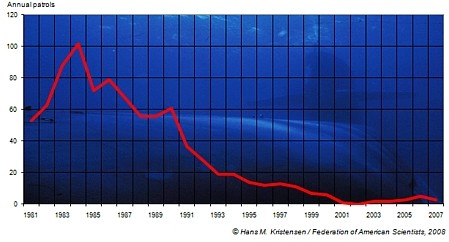 |
| Russian SSBNs conducted only three deterrent patrols in 2007, a decline from five in 2006. |
.
The reason for the shift is unclear. Perhaps the Russian navy is still not over the financial and technical constraints that hit it after the collapse of the Soviet Union. SSBNs can launch their missile from pier side if necessary, although such a posture essentially converts each SSBN into a very soft and vulnerable target. Russia might simply have decided that it’s no longer necessary to maintain a continuous nuclear retaliatory force at sea, and that a few training patrols are all that’s needed to be able to deploy the SSBNs in a hypothetical crisis if necessary.
SSBN Patrol Areas
Little is known in public about where Russian SSBNs conduct their deterrent patrols. However, in 2000, U.S. Naval Intelligence released a series of rough patrol maps for Soviet/Russian SSBNs that showed the locations of the patrol areas used by Delta IV and Typhoon class SSBNs in the late-1980s and 1990s (see Figure 2). The few SSBNs that occasionally sail on patrol today probably use roughly the same areas.
|
Figure 2: |
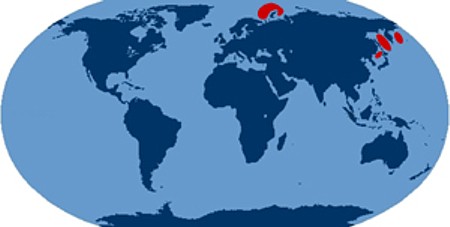 |
| Russian SSBN patrol areas today are probably similar to those used in the 1990s. |
.
In Perspective
The decline in SSBN patrols is in stark contrast to Russian bomber and surface fleet operations in 2006-2007, which are said to have increased in scope and reach. For now, at least, SSBN patrols are not used to “signal” Russian status.
Approximately 20 percent of Russia’s strategic warheads are sea-based. But with the upcoming replacement of old Delta III SSBNs and their three-warhead missiles with the new Borey SSBNs (the first of which is scheduled to enter service later this year) with six-warhead missiles, the SSBNs’ share of the posture might increase to approximately 30 percent by 2015.
Overall, the Nuclear Notebook estimates that Russia currently has approximately 5,200 nuclear warheads in its operational stockpile, including some 3,110 strategic and 2,090 non-strategic warheads. Another 8,800 warheads are thought to be in reserve or awaiting dismantlement.
Additional information: Russian Nuclear Forces 2007, Nuclear Notebook, Bulletin of the Atomic Scientists
